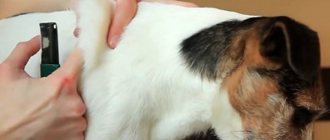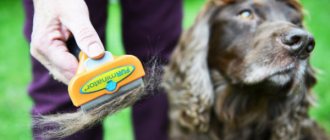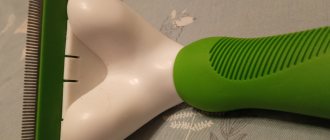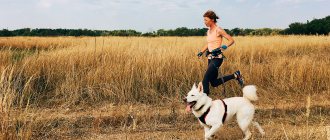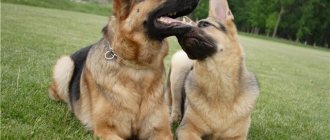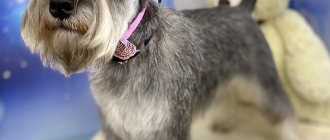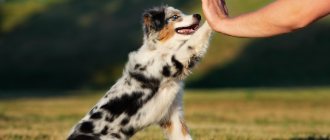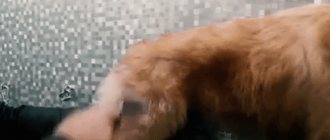ZKS for dogs originated in the 20th century in the Soviet Union. It showed its effectiveness in training service dogs, and soon passing the standards of Basic Canine Training and Protective Guard Service became a prerequisite for breeding service dogs. Over time, amateur dog breeders also became interested in this training system.
Which dogs need a course and why?
Certain breeds are predisposed for training: shepherd dogs, Rottweilers, Dobermans, Russian terriers, American bulldogs. The choice falls on them due to the fact that they are larger than the average dog. It should also be noted that overly nervous dogs are not trained in this system.
A dog can begin PCL training only after it has completed a general OKD course. The reason lies in the fact that first you need to raise the dog and only then start training it, instilling service skills.
The attention of many owners turns to the ZKS due to the fact that the pet becomes more controlled and calm after training.
From now on, the owner will be able to let the child go for a walk with the dog without fear that something will happen to him. Additional Information. In addition, ZKS becomes a prevention of canine diseases. The pet will become more resilient, in the future he will not have problems with the musculoskeletal system, and the nervous system will be safe.
Selecting an item by smell
To develop this skill, four to five objects are used, one of which is similar to the smell of that object. which the dog remembered earlier. It is best to use wooden objects or ordinary scraps of fabric. Objects are laid out at a distance from each other in different places on the site. An object with the desired smell is placed at a distance of three meters from the sampling site. The dog is allowed to smell the thing. after which the command “Look” is given and with a gesture the dog is directed towards the location of the objects to be sampled. The dog must sniff each object and find the desired object by smell. Ideally, the dog should take into its mouth and bring only the item it is looking for.
ZKS for dogs – what is it, what does the course include?
ZKS for dogs is a system of exercises based on controlling aggression and directing it in the right direction. It is for this reason that it is dangerous to do this on your own, since, if unsuccessful, the pet may become either overly cowardly or overly aggressive.
Detention of the violator
It is based on training your pet to detain an intruder. In the future, the pet will be able to protect the house from thieves and dangerous people.
During the training process, the dog must pass the following standards:
- detain the intruder;
- escort him to the checkpoint;
- search the intruder;
- give a presentation to police officers.
Protection of things and the owner
An important skill in the training process will be teaching the pet to guard and protect the owner’s things and himself. The owner will be able to safely leave the defender with the stroller at the store or let the child go for a walk. The dog will guard.
The dog is an excellent guard and protector
Sampling an item by smell
This skill is based on the development of the sense of smell, which will help the owner find the thing he needs. In addition, the police train the dog to do this in order to find criminals or something they need.
Note! To find something, a pet must know the original smell of an object or person; this is an important condition.
Attitude to the shot
One of the key components of ZKS training is the dog’s reaction to a shot – a perceived threat. A shot will mean danger for the owner, so the training consists of teaching the pet actions that will help save him.
Detention and escort of the violator
Once the pet has apprehended the intruder, the key task for him will be to take care of where to direct the intruder. Escorting is carried out under the strict control of the pet. If the owner's life is in danger, the pet protects him and keeps the enemy under control. In addition to being in control, the dog can also search him.
Note! The dog's final destination is the police station. If the dog follows all the instructions and passes the exam, he will receive a diploma.
How to teach a service dog the command “Guard!”
A dog that guards your item must be attentive and wary of strangers, clearly and for a long time executing the command “Place!”
During the first lessons, put a collar on the dog and tie it to a tree or post on a short leash. To teach your dog to guard, give the command “Down!” and place your item in front of her so that she can reach it (a small backpack or bag). Command “Guard!” and stay close to the dog.
After 15-20 seconds, an assistant comes out of the shelter and calmly walks past you several times in different directions. If at this moment the animal begins to behave aggressively (growls, barks, rushes at the helper), immediately give him the command “Place!” and “Lie down!” Your task is to achieve an attentive and calm reaction from the dog to a person passing by, who does not take any action in relation to the dog or the protected item.
If the dog lies calmly by the backpack (bag), the assistant tries to pick it up; if necessary, he moves or pulls the protected item towards himself, attracting the animal’s attention. When attempting to take an object, quickly give the command “Guard!” As soon as the dog growls or lunges at the helper, he should run for cover, and you encourage the animal by exclaiming “Good!” and stroking. After the assistant leaves, calm the dog down and repeat the exercise after a while. To increase the dog’s attentiveness and aggressiveness, the assistant should try to pick up the item with one hand, and with the other, lightly but sharply hit the dog on the front paws with a thin rod, and then run for cover. If the dog tries to chase the helper, sharply give the command “Place!”
Gradually, the exercise of guarding with service dogs becomes more complicated. To do this, the assistant should try to calm the dog and distract him from the protected item with affectionate treatment and treats. He calmly approaches the animal, calls its name, tries to treat it with a tasty piece, while at the same time trying to take the object. If the dog is distracted by a treat, the assistant lightly but sharply hits it on the front paws several times with a rod. If, despite this, the dog insists on taking the treat, give the command “Face!”, and if it tries to pick it up from the ground, immediately stop it with the exclamation “No!”
Your service dog is ready to guard things if it carefully guards them for 20 minutes or more, does not move away, calmly reacts to an assistant passing by, actively attacks him when trying to pick up luggage, but does not pursue him when he runs away.
Possible mistakes: you always involve the same person in the exercise as an assistant (the dog gets used to working only with him); cause pain to the animal while giving the command “No!” (the dog may get scared); the assistant hits the dog’s front paws too hard with the rod (the dog may refuse to work); use the same thing (the dog gets used to guarding only this); the helper always behaves monotonously (the animal develops a stereotype of attacking actions towards him).
What teams are included in the program?
To control your pet, there are key commands that help develop skills during the training process. Among the fundamental commands we can highlight “Near!” and “Come to me!”, since the owner must always be on alert.
In addition, there is a list of commands that must be performed without voice, using gestures: “Lie down!”, “Stand!”, “Sit!” The command must be carried out unquestioningly, even if the owner is not near the pet.
Before the pet begins to study the PCL, he must master all the basics of the PCL. Among the preparatory techniques required for mastering all provisions are the development of:
- olfactory and search response;
- active defensive reaction.
Once the basics are mastered, the main course begins. The pet will be trained to:
- finding objects using smell;
- detaining the attacker, searching him and escorting him;
- protection of things and property;
- learning the skill of not agreeing to eat food given by strangers.
The required age to master the program is at least more than one and a half years old at the time of passing the exam. Once the pet passes the exam, he receives a diploma of the degree earned upon passing.
Owner's security
To master this skill, the dog is seated next to the left side and the command “Guard” is given in a strict intonation. The trainer or assistant approaches the animal and lightly pinches the dog on the side, after which he quickly leaves. This procedure is carried out several times. The main thing in the first two or three lessons is not to frighten the dog, but to develop courage, stimulating the dog to attack on command. After mastering the first skills, the task is gradually made more difficult. the assistant takes the twig, approaches the owner and begins to lightly hit the dog on the side with the twig. The dog must respond to the attacker on command, showing aggression. Over time, they gradually increase the number of assistants who will appear from different hiding places.
Errors during training
When training a dog, you should beware of mistakes that can harm the entire process. The first thing to always remember is that a dog cannot perceive a person’s words and obey immediately if it has not been trained. Another mistake is the illogical sequence of skill development. The dog will not be able to learn commands as well as it should if you start with something difficult rather than easy.
It is important to take into account the characteristics of each pet when training. You need to base yourself on your pet’s character so as not to be disappointed if he couldn’t learn everything as he should. When the owner teaches commands, it is important to use your voice as correctly as possible. There is no need to be too strict and too soft. Each command must be pronounced with the appropriate intonation.
Additional Information. It is important to analyze every action of the dog and evaluate the next step. In order for your pet to become part of the guard dog class, it is important to pay a lot of attention to its care. Training should be harmonious and systematic. There is no need to put pressure on your pet; it is important to assimilate each stage properly so that health and mental problems do not arise.
If the owner trusts an experienced dog handler and helps the pet mentally, he will learn all the necessary commands. After this, the entire program will be mastered, and the dog will become a professional security guard, protecting the owner’s family and property.
Requirements for animals
Not every dog is ready to start training in protective guard service. Dog handlers carefully select animals:
- This must be a puppy no older than one year.
- The animal must be mentally stable, stress-resistant, have strong nerves, and not aggressive.
- The dog must always listen to the owner and follow various commands.
- The dog must be healthy and physically developed. She should have no problems with her jaw, teeth, vision, hearing or sense of smell.
Before training in the ZKS system, you must first pass the OKD (system of training methods). After this, the standards are also passed, and upon successful completion, a certificate is issued.
Dog handlers give preference to dogs that have a well-developed defensive reflex and strong external characteristics (developed muscles, thick hair). Before accepting an animal for training, veterinarians carefully examine each animal, determine whether it sees well, hears well, what is the condition of its teeth and whether its sense of smell is properly developed. A professional dog handler determines the dog’s character type and whether it can be flexible and not cowardly.
Main guard breeds
Almost any dog can be trained to guard a house or territory, even a mongrel one. Sometimes mongrels are much smarter and smarter than their noble brothers and loudly and promptly warn their owner about danger. They are also jokingly called the Siberian Shepherd. But there are certain stereotypes and views in society , therefore, when they talk about watchdogs, they usually mean shepherd dogs.
These include:
- German.
- Caucasian.
- Central Asian.
- Eastern European.
- South Russian.
The following dogs are also classified as guard dogs:
- Miniature Schnauzer.
- Giant Schnauzer.
- Rottweiler.
- Moscow watchdog.
- Doberman.
- Saint Bernard
- The Schipperke is a small indoor breed.
Naturally, this list is incomplete, since many more breeds can be a good watchdog. By and large, watchdog qualities are not a matter of breed, but of upbringing. It takes a lot of time and effort to turn a naughty puppy into a smart dog with excellent guard skills.
Conditions for passing standards
For successfully passing the standards, dogs are awarded certificates. You can also demonstrate your skills in competitions. They are held at the national, regional and city level, as well as within a specific club.
You must complete all skills in the course to receive the certificate. Depending on the technique of performing the tests, the animal is awarded a certain degree for each of them. If all but one skill is demonstrated perfectly, the minimum score received for the failed test will be included in the certificate.
A point system is used to evaluate competitors. In addition to pets, their owners are also assessed. Rough handling of the animal or additional actions that distort the demonstration of skills will be subject to fines. At the end of the test, the owner receives an oral assessment from the judges.
Animals do not thoroughly understand human speech, so when teaching them it is important to use intonation and avoid saying unnecessary words. The same tone and attempts to communicate while practicing skills are the main mistakes when learning independently.
For the safety of those around you, it is better to entrust your pet to experienced dog handlers. In this case, after passing the ZKS, he will be able to demonstrate his skills without causing harm to ordinary passers-by.
The article is of a recommendatory nature. Contact a specialist!
Let fellow pet lovers know what you think.
Reaction to shots
A guard dog should be calm about gunshots and other loud sounds. Flinching or hiding are considered serious training problems. You can read how to properly train a dog to hear shots in the article - What to do if your dog is afraid of loud sounds .
How is a skill tested in the exam? This skill is tested while the dog is guarding the post. When she attacks the intruder, the sentry fires a shot. The animal should not loosen its grip or stop barking.
Detention of the violator
At the training site, the dog is given the command “Sit” or the pet is led by the command “Near” from the left side by the collar. A trainer in a protective suit or sleeve suddenly appears from behind the shelter and begins to attract the dog’s attention with active movements. After which he sharply moves in the direction opposite to the dog. After the command “Fast”, the dog must follow the assistant and apprehend him. After detention, the dog is given the command “Stop”, “Fu”. after which the animal must loosen its grip and sit opposite the detainee. Also, after being detained, the dog, on the command “Come to me,” must unquestioningly approach the owner.
